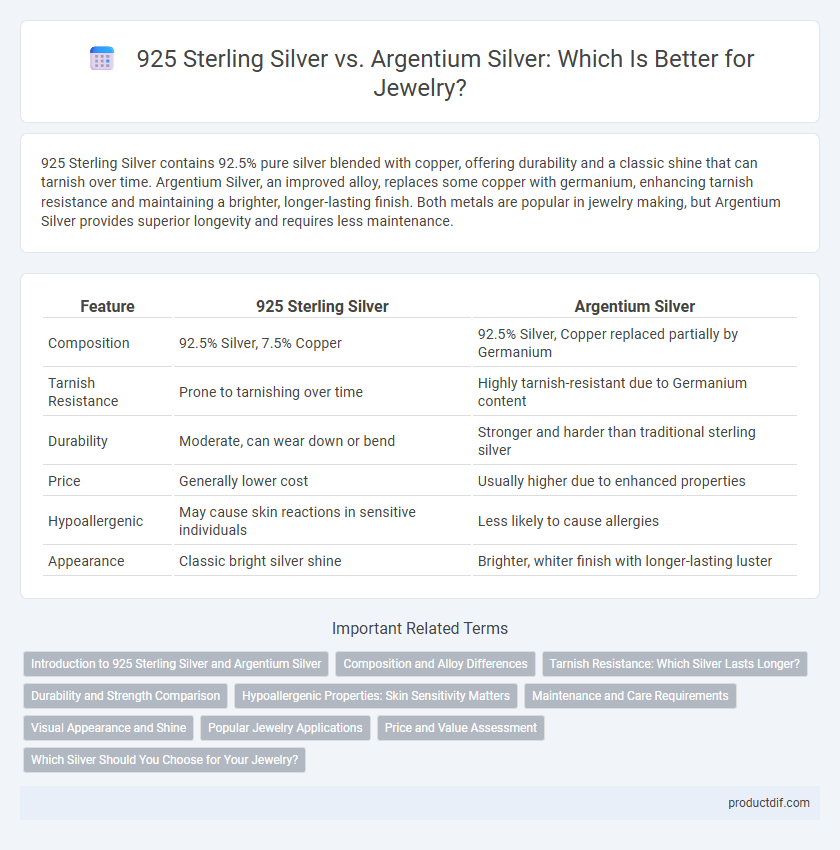925 Sterling Silver contains 92.5% pure silver blended with copper, offering durability and a classic shine that can tarnish over time. Argentium Silver, an improved alloy, replaces some copper with germanium, enhancing tarnish resistance and maintaining a brighter, longer-lasting finish. Both metals are popular in jewelry making, but Argentium Silver provides superior longevity and requires less maintenance.
Table of Comparison
| Feature | 925 Sterling Silver | Argentium Silver |
|---|---|---|
| Composition | 92.5% Silver, 7.5% Copper | 92.5% Silver, Copper replaced partially by Germanium |
| Tarnish Resistance | Prone to tarnishing over time | Highly tarnish-resistant due to Germanium content |
| Durability | Moderate, can wear down or bend | Stronger and harder than traditional sterling silver |
| Price | Generally lower cost | Usually higher due to enhanced properties |
| Hypoallergenic | May cause skin reactions in sensitive individuals | Less likely to cause allergies |
| Appearance | Classic bright silver shine | Brighter, whiter finish with longer-lasting luster |
Introduction to 925 Sterling Silver and Argentium Silver
925 Sterling Silver consists of 92.5% pure silver alloyed with 7.5% other metals, mainly copper, to enhance its durability and strength for jewelry use. Argentium Silver is an innovative variation of sterling silver that replaces some copper with germanium, providing increased tarnish resistance and improved hypoallergenic properties. Both metals maintain the classic silver appearance, but Argentium Silver offers superior longevity and requires less maintenance compared to traditional 925 Sterling Silver.
Composition and Alloy Differences
925 Sterling Silver consists of 92.5% pure silver alloyed primarily with copper, enhancing durability but prone to tarnishing over time. Argentium Silver modifies this standard by replacing some copper with germanium, which improves tarnish resistance and increases hardness. The germanium addition in Argentium creates a self-healing oxide layer, making it more durable and less reactive than traditional 925 Sterling Silver.
Tarnish Resistance: Which Silver Lasts Longer?
Argentium Silver offers superior tarnish resistance compared to 925 Sterling Silver due to its higher purity and the addition of germanium, which forms a protective oxide layer on the surface. While 925 Sterling Silver, composed of 92.5% silver and 7.5% copper, tends to oxidize and darken over time, Argentium Silver maintains its bright finish longer without frequent polishing. Jewelry made from Argentium Silver ensures lasting shine and durability, making it ideal for those seeking low-maintenance silver pieces.
Durability and Strength Comparison
925 Sterling Silver, composed of 92.5% pure silver and 7.5% other metals like copper, offers excellent durability but is prone to tarnishing and occasional bending over time. Argentium Silver, an advanced alloy containing a minimum of 92.5% silver with added germanium, provides superior strength and tarnish resistance, making it more durable for daily wear. The enhanced hardness and oxidation resistance of Argentium Silver result in longer-lasting, low-maintenance jewelry compared to traditional 925 Sterling Silver.
Hypoallergenic Properties: Skin Sensitivity Matters
925 Sterling Silver contains 92.5% pure silver mixed with 7.5% copper, which can cause allergic reactions in sensitive skin due to copper content. Argentium Silver replaces some copper with germanium, enhancing hypoallergenic properties and reducing tarnish, making it ideal for those with skin sensitivities. Choosing Argentium Silver jewelry minimizes skin irritation while maintaining durability and a bright, lasting finish.
Maintenance and Care Requirements
925 Sterling Silver requires regular polishing to prevent tarnish caused by exposure to air and moisture, and should be stored in airtight containers with anti-tarnish strips for optimal maintenance. Argentium Silver, an advanced alloy containing germanium, resists tarnishing much better, reducing the need for frequent cleaning and making it ideal for low-maintenance jewelry care. Both metals benefit from gentle cleaning with a soft cloth, but Argentium Silver offers superior durability against corrosion and discoloration over time.
Visual Appearance and Shine
925 Sterling Silver features a classic bright white luster with a smooth, reflective surface that enhances detailed craftsmanship. Argentium Silver boasts a higher shine and a more brilliant, mirror-like finish due to its unique alloy composition, which includes germanium for enhanced corrosion resistance and tarnish prevention. The visual appearance of Argentium often results in a cleaner, whiter shine that maintains its brilliance longer compared to traditional 925 Sterling Silver.
Popular Jewelry Applications
925 Sterling Silver remains a preferred choice for classic jewelry pieces like rings, earrings, and bracelets due to its proven durability and affordability. Argentium Silver, known for its tarnish resistance and enhanced brightness, is popular in contemporary designs and intricate jewelry that require less maintenance. Both metals are widely used in handcrafted and designer jewelry, appealing to customers seeking quality and longevity.
Price and Value Assessment
925 Sterling Silver offers a classic choice with widespread availability and a lower price point, making it accessible for most jewelry buyers. Argentium Silver, featuring a higher purity with added germanium, provides enhanced tarnish resistance and durability, which justifies its premium pricing and long-term value. When assessing price versus value, Argentium Silver delivers better longevity and reduced maintenance costs, appealing to those seeking lasting quality over initial affordability.
Which Silver Should You Choose for Your Jewelry?
925 sterling silver, composed of 92.5% pure silver and 7.5% copper, offers classic durability and a bright finish ideal for traditional jewelry designs. Argentium silver contains a minimum of 92.5% silver with the addition of germanium, which enhances tarnish resistance and strength, making it excellent for modern, low-maintenance pieces. For jewelry that balances timeless appeal with superior longevity and reduced upkeep, Argentium silver is the optimal choice.
925 Sterling Silver vs Argentium Silver Infographic

 productdif.com
productdif.com